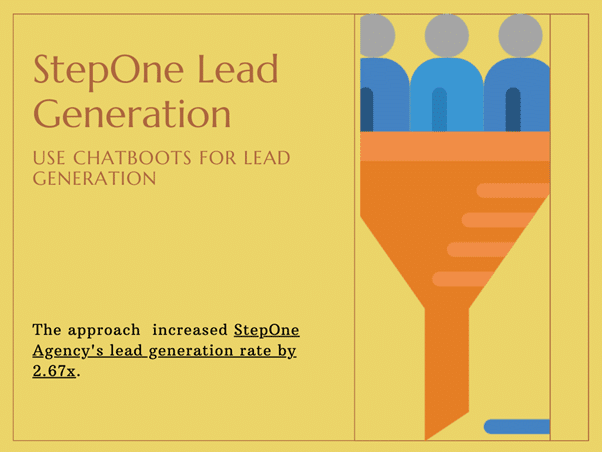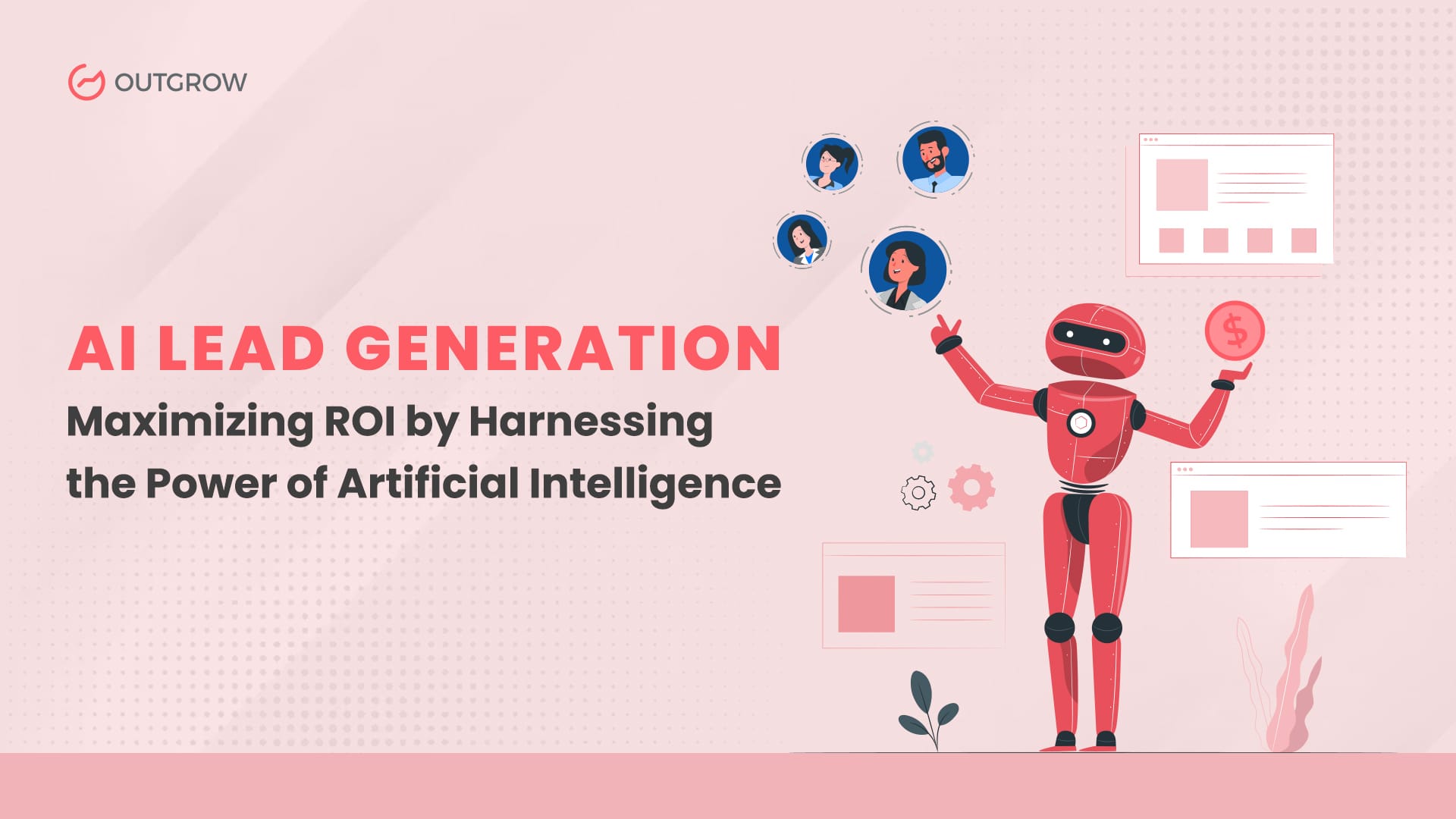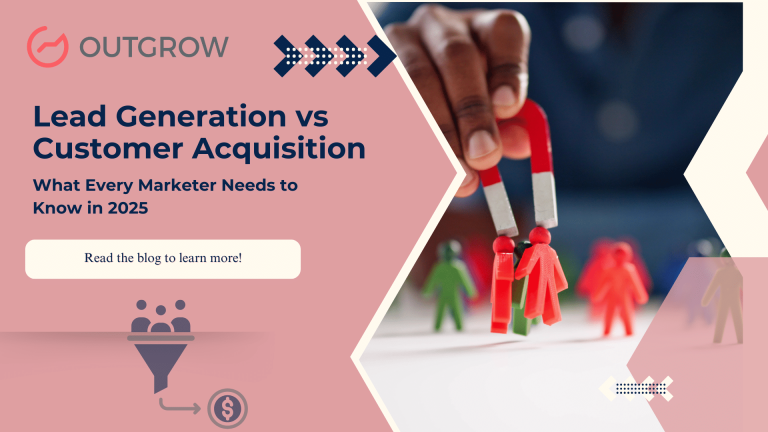AI Lead Generation: Maximizing ROI by Harnessing the Power of Artificial Intelligence
Table of Contents
AI lead generation has become an increasingly crucial aspect of any business in today’s highly competitive market. To increase revenue and grow the business, it is essential to generate relevant and qualified leads.
However, traditional lead generation methods can be time-consuming and expensive. That’s where Artificial Intelligence (AI) comes into play. AI can help businesses automate and streamline the lead generation process, allowing them to maximize their ROI.
So let’s dive in and understand how can AI boost lead generation efforts and the best practices to implement it in your marketing processes. We will also talk about some brand case studies and the potential challenges and risks of this method.
Overview of How AI Can Improve Lead Generation and Boost ROI
AI is transforming the way businesses operate. It has the potential to revolutionize lead generation by enabling companies to gather more data, analyze them more quickly, and make better decisions. AI-powered lead generation tools can help businesses identify and prioritize high-quality leads, resulting in higher conversion rates and increased revenue.
For example, using an AI-powered compelling infographic can help businesses attract potential leads and improve their conversion rates. AI-powered infographics are a type of visual representation of data or information that is created using artificial intelligence technology. These infographics use algorithms to analyze and interpret complex data sets, and then generate visual representations that are easy to understand and engaging for the audience.
Moreover, the use of AI can streamline the process to create infographics, saving time and resources while still producing high-quality content. Overall, AI-powered infographics can be a cost-effective and efficient way to enhance lead generation efforts.
AI can also automate and streamline lead nurturing, allowing businesses to engage with prospects in a more personalized and timely manner. This not only helps build relationships with potential customers but also ensures that businesses don’t miss out on any opportunities. Also, businesses can leverage an AI voicebot to provide instant support and guidance, creating seamless and efficient interactions throughout the lead nurturing process.
How Can Different Types of AI Tools Enhance Lead Generation?
There are several AI tools and technologies that businesses can use to enhance their AI lead generation processes. One of the best ways/tools to generate relevant and qualified leads is through AI chatbots. AI chatbots are computer programs that simulate human conversation using Natural Language Processing (NLP) and Machine Learning (ML) algorithms. They can be integrated into a company’s website or social media platforms, allowing businesses to engage with customers 24*7.
AI chatbots can answer customer queries, provide product recommendations, and even make purchases on behalf of the customer. They can generate qualified leads by collecting customer information, such as contact details and preferences.
Chatbots can also help businesses to engage with potential leads quickly and efficiently, providing a personalized experience that can increase the chances of conversion.
Another AI tool for lead generation is predictive analytics, which uses machine learning algorithms to analyze data and predict future behavior. Predictive analytics can be used to identify high-quality leads, prioritize them based on their probability of conversion, and provide insights into how to engage with them most effectively.
Businesses can further enhance lead generation by implementing intelligent virtual agents (IVA). These self-service options offer a human-like experience and empower potential customers to seek assistance independently.
Finally, personalization engines use AI algorithms to analyze data from multiple sources and provide personalized recommendations and offers to customers. By tailoring their approach to each customer’s unique needs and preferences, businesses can increase the chances of conversion and improve their overall ROI.
Some Industry Examples of AI Chatbots in Lead Generation
1. StepOne Agency created two chatbots using Outgrow, one of which was designed for Compare CPA to calculate accounting expenses. The chatbot asked users revenue-related questions and provided price ranges for each answer. After answering all the questions, the chatbot requested users’ lead information, with two disclaimers. These disclaimers stated that the user would only be contacted if a cheaper accounting service was found, and only one service would contact them. This approach increased StepOne Agency’s lead generation rate by 2.67x.

2. BabyCenter implemented a Facebook messenger chatbot to provide personalized content to users and drive traffic to its website. The chatbot learned from user interactions and provided increasingly helpful advice
And this resulted in an average read rate increased up to 84% and the company saw a click rate from chatbot to website of 53%. This helped in generating leads from social media and directing them to the website.

The chatbot also provided valuable insights into user behavior and preferences, which helped BabyCenter improve its content strategy and increase user retention. Overall, the chatbot was a successful tool for improving user engagement and generating new traffic.
6 Ways Organizations Can Maximize Their ROI From AI-powered Lead Generation
1. Set Clear Goals and Strategy
Before implementing AI-powered lead generation, businesses must have a clear understanding of their goals and strategy. This includes identifying the target audience, defining key performance indicators (KPIs), and developing a plan to measure and optimize the ROI.
By having a well-defined strategy, businesses can ensure that their efforts are aligned with their overall marketing and sales objectives, and can make informed decisions about how to allocate resources and optimize their approach. This, in turn, can help maximize the ROI from their AI-powered lead generation efforts.
2. Invest in Data Quality and Integration
AI algorithms rely heavily on data, which means that businesses must ensure that their data is accurate, reliable, and integrated across multiple sources. This includes data cleansing and data integration tools to ensure that the data collected is consistent and up-to-date. Additionally, adopting an integrated data platform can streamline the process, allowing for seamless data management and more efficient analysis.
Businesses should also invest in data analysis tools to gain insights from their data and identify patterns and trends that can inform their lead generation strategy. By leveraging data analysis tools, businesses can identify new opportunities and make data-driven decisions that can maximize their ROI.
Power BI is one example of a business intelligence tool that enables users to connect and analyze data from various sources, create interactive visualizations, and gain insights into their data. Businesses can use Power BI to identify patterns and trends in their data, which can be used to optimize their lead generation strategy and maximize ROI.
Additionally, businesses should consider implementing machine learning algorithms that can continuously learn from their data and improve their lead generation processes over time. Overall, investing in data quality, integration, analysis, and machine learning can significantly enhance the effectiveness and ROI.
3. Continuously Monitor and Optimize
AI lead generation is not a one-time fix, but rather an ongoing process that requires continuous monitoring and optimization. Businesses must continuously evaluate their results, adjust their strategy as needed, and invest in ongoing training and development for their AI-powered systems. It can also be crucial to use mentoring software to continuously train your employees on new AI systems.
4. Leverage AI for Personalization
Personalization is critical in today’s competitive business landscape, and AI lead generation can provide a highly personalized experience for customers. By using AI algorithms to analyze customer data and behavior, businesses can provide personalized recommendations, offers, and experiences.
Another way businesses can leverage AI for personalization is by using predictive analytics to anticipate customer needs and preferences. By analyzing historical data, businesses can identify patterns and trends that can help them predict future customer behavior and preferences. This can enable businesses to proactively tailor their marketing and sales strategies to the needs of their customers, providing a more personalized experience that can increase the chances of conversion.
5. Consider Outsourcing
Implementing AI lead generation can be a complex and resource-intensive process. Therefore, businesses should consider outsourcing some or all of their AI-powered lead generation processes.
Outsourcing can also provide businesses with access to specialized tools and technologies that they may not have in-house. For example, some third-party providers may have access to proprietary algorithms and data sources that can significantly enhance the accuracy and effectiveness of AI lead generation processes.
6. Identification and Prioritization of High-Quality Leads
Identifying and prioritizing high-quality leads is one of the key ways that organizations can maximize their return on investment (ROI) from AI-powered lead generation. By leveraging AI to analyze data on customer behavior and demographics, organizations can identify patterns and characteristics of their most valuable leads.
This information can then be used to create targeted campaigns and messaging that are more likely to resonate with these high-value leads, increasing the likelihood of conversion and driving revenue. Additionally, by focusing on high-quality leads, organizations can optimize their resources and efforts, reducing waste and ultimately increasing their ROI from lead generation.
Best Practices for Implementing AI in Lead Generation
Prioritize transparency and ethical considerations in AI implementation. We must ensure that AI is used responsibly and that customer privacy and data security are maintained.
When implementing AI lead generation, it’s important to remember that it is a tool to enhance and optimize existing processes, not a solution in itself. By following these best practices, businesses can maximize the benefits of AI while minimizing the risks and ensuring long-term success.
Additionally, several case studies of successful AI-powered lead generation demonstrate the effectiveness of these best practices. These case studies provide real-world examples of how businesses have used AI to improve their AI lead generation processes and achieve significant ROI improvements.
Case Studies of Successful AI-powered Lead Generation
Several companies have successfully implemented AI lead generation and seen significant improvements in ROI.
Following are some of the successful AI lead generation campaigns.
Web Traffic of “Tomorrow Sleep” Boosts Upto 10,000%
Sleep system startup, Tomorrow Sleep, used an AI solution called MarketMuse to improve their content planning and production. The platform’s AI research application helped the company understand the high-value topics they needed to focus on. They then used one of the tool’s advanced analytics applications to see where competitors ranked for each topic. This allowed them to identify gaps and opportunities in their content plan.

The result was a 10,000% increase in website traffic, with 400,000 monthly visits, multiple rankings in search results, and domain authority to secure Google’s featured snippet for specific results.
Artificial Intelligence and Machine Learning Helped Sistema Brasileiro de Televisão (SBT)
Through the integration of artificial intelligence in its social media strategy, SBT experience significant improvements in its social media performance. After just four months of incorporating AI technology, the company’s social media pages witnessed an increase in daily clicks by 25%, with organic impressions increasing by 61%. SBT also observed a remarkable 52% increase in daily impressions on Facebook, and Twitter pageviews surged by 63%.

Besides boosting performance, SBT increased workflow efficiency by utilizing automation, resulting in significant time savings of 14 hours per day. In total, the SBT team was able to share almost 40,000 posts via AI in just four months.
Overall, these case studies demonstrate the potential of AI to transform lead generation and drive significant improvements in ROI.
Potential Challenges and Risks of AI-Powered Lead Generation
Companies that increasingly rely on artificial intelligence (AI) need to address several potential lead generation challenges and risks. AI has been shown to increase efficiency and accuracy in identifying and qualifying leads, but it also has potential ethical concerns and risks.
One of the primary concerns with using AI for lead generation is the potential for biased decision-making. AI algorithms are only as unbiased as the data they are trained on. And if the data is biased, then the algorithm will also be biased.
For example, a software company that only trains its AI algorithm on data from sales to larger companies may bias the algorithm towards prioritizing larger companies for lead generation. This could result in smaller companies being excluded from the lead generation process and missed opportunities for the software company. To prevent this bias, the company should use a more diverse range of data sources to train its AI algorithm.
This can lead to discriminatory practices that disproportionately impact certain groups of people. Another concern is the potential for privacy violations. This often involves the collection and analysis of large amounts of personal data, which can be vulnerable to hacking and other security breaches.
Importance of Transparency and Accountability in AI-powered Lead Generation
To address these concerns, it is essential for companies to prioritize transparency and accountability in their AI lead generation processes. This includes being transparent about how data is collected, analyzed, and used, as well as providing individuals with clear information about their rights regarding their personal data.
Companies should also establish processes for monitoring and auditing their AI algorithms. This is to ensure that they are making fair and unbiased decisions.
One tool that can help companies achieve transparency and accountability in AI-powered lead generation is a pitch deck. A pitch deck can help companies create clear and detailed proposals. This includes information about how we collect and analyze data, and how we make decisions. By using a pitch deck, companies can provide stakeholders with a clear understanding of their lead generation processes. This can help build trust and accountability.
In Conclusion
AI-powered lead generation has numerous benefits, including increased efficiency, improved accuracy, and better customer targeting. By automating time-consuming and repetitive tasks, businesses can free up resources and focus on more strategic activities.
However, there are also potential challenges and risks associated with AI-powered lead generation, such as ethical concerns, lack of transparency, and potential biases. Therefore, it is essential for businesses to approach AI implementation carefully and with a focus on accountability and transparency.
Despite the potential challenges, the benefits of AI-powered lead generation far outweigh the risks. Therefore, businesses have not yet considered implementing AI. They should take the time to evaluate its potential benefits and explore its capabilities.
By leveraging AI, businesses can maximize their ROI and stay competitive in a rapidly evolving marketplace. It is important to approach AI implementation with caution and care, but ultimately, the potential rewards are significant.


![Qualitative and Quantitative Research – [Difference+Template]](https://outgrow.co/blog/wp-content/uploads/2023/05/Blogs-min-1536x768-1-1-1.png)
